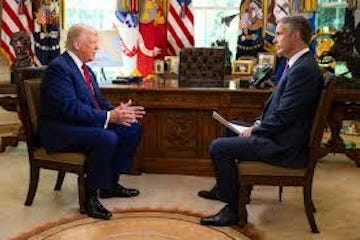We just passed Day 100 of the Trump 2.0 administration. By every measure, it has been the most chaotic, autocratic, fact-free beginning to a presidential administration in modern memory.
Our collective reaction to the last 100 days understandably has been shock, disorientation, hopelessness, anger, frustration, and a sense of helplessness. We cannot stay in this space. Things have to change.
This is the first of three posts on what some of those changes might be. Today I’ll look at the role of the media. On Friday, I’ll dive into the messy conflict about “what Democrats should do”. Monday, I want to look at what has to change among citizens like us.
Failing Media Strategies
In the last week, anticipating Day 100, three news entities released interviews with President Trump. He spoke to Erik Cortellessa and Sam Jacobs from Time, Ashley Parker and Michael Scherer of The Atlantic (paywalled) and then last night with Terry Moran of ABC News.
I haven’t read the transcripts closely (because I’m not a masochist!) but have skimmed enough to get the pattern. First, they start with some flattery. The Time folks began by marveling at the accumulation of power in the White House. The Atlantic team told the story of Trump’s exile after 2020 and his comeback, citing his book “The Art of the Comeback” before getting to questions. Moran’s clip begins by asking Trump about his “improvements” to the Oval Office.
Then they get to their questions. I think they all want to be Jonathan Swan or Chris Wallace but they really hadn’t done the kind of homework that those interviewers did. These two remain the only people who have really forced Trump to answer a question on their terms and even that was hit or miss.
The questions were predictable: Immigration, El Salvador, the Courts, Prices, Impacts of Tariffs. If you watched any coverage of the campaign, you knew the answers. Criminals brought in from other countries. MS-13 and TdA. Inflation was near zero when he was president and Biden ruined it. Groceries, gasoline, and eggs are now cheaper. An overwhelming electoral mandate. And, of course, the 2020 election was stolen. In most cases, the answers given to Time wind up being verbatim responses to the others. And the interviewers seem powerless to do anything about it. Moran tried to push back on the photoshopped MS-13 tattoos but Trump was having none of it. Look at the framing in this excerpt from The Atlantic interview:
But in nearly every conversation we had with various Trump advisers, they told us that delivering on what people had voted for was in fact essential to holding the House and the Senate in the 2026 midterms. Trump himself has his eyes on a larger, long-term political realignment. “It’s a much different party,” he told us. “I got 38 percent of the male Black vote. Nobody knew that was possible. That’s a lot. I got 56 percent of Hispanics. How about that one? Every county along the Texas border is Hispanic. I won every one of them.” Though every single number he cited was wrong, the general thrust of his observation was correct. (emphasis mine)
There is literally no response to the cavalcade of falsehoods, made up numbers, and stream of consciousness argument that happens in these interviews. Fact-checking just makes him mad and he doubles down or spins a new explanation. Daniel Froomkin, in his PressWatch SubStack offered suggestions about how the interviewer could respond:
Here are some excerpts from the Time interview, and how I wish he had been confronted [just a couple of his examples]:
TRUMP: We were losing $2 trillion a year on trade, and you can’t do that. I mean, at some point somebody has to come along and stop it, because it’s not sustainable. We were carrying other countries on our back with, you know, with trade numbers, with horrible numbers, and we’ve changed it.
WHAT TIME SHOULD HAVE SAID: Mr. President, surely you know that $2 trillion figure is wrong. The entire U.S. trade deficit with the world is less than $1 trillion. And that doesn’t mean we’re “losing” the money; we’re buying things with it. Do you understand that?
TRUMP: I had the head of Walmart. I had the head of Home Depot and the head of Target in my office. And I’ll tell you what they think, they think what I’m doing is exactly right.
WHAT TIME SHOULD HAVE SAID: In fact, as journalists have reported, the CEOs warned you that your tariff policy could disrupt supply chains and lead to empty shelves in the coming weeks. How do you interpret that as saying they support you?
While I agree with Froomkin on the need for better engagement from interviewers, the format just won’t allow it. Even after Trump calls the interviewer “Nasty”, he drops back into his standard patter.
Then there is the problem of the Executive Orders. There have been more in the first 100 days that in Obama’s entire first term. Many are of questionable legality, as courts have made clear. Others are promotional memos designed to show the president’s strength. Margaret Sullivan, former public editor of both the New York Times and Washington Post who now writes for the Guardian, wrote this in her SubStack.
But as I’ve noted before, many people never get very far into a news story. They scan a headline or a social media post, and come away with a conclusion that’s incorrect. And while it’s true that it’s difficult to get much nuance or context into a six- or eight-word news alert, it’s the media’s responsibility not to leave the public with a false impression.
To put it bluntly, these orders aren’t the law. Legally, executive orders essentially are memos to Trump’s subordinates to act within their existing powers. Those powers are authorized by laws enacted by this organization you might have heard of? It’s called Congress. (And, after all, Congress gets top billing in Article I of the Constitution as the body that gets all legislative powers. The president, says Article II, is supposed to take care that the laws be faithfully executed.)
And yet the press continues to go to Karoline Leavett “briefings” where she describes these orders as fait accompli. Or they want to be present for celebratory cabinet meetings in which cabinet officers cite these orders as if they were legislation passed by Congress while donning red hats and singing Trump’s praises.
Trump has returned to his Covid briefing schedule. There are daily press availabilities where he makes a bunch of claims and the press corps reports out what he said. On top of these empty events, there is the continual reporting on his Truth Social posts.
None of this is what we need from the media.
They play into the hands of an administration that wants to communicate dominance and incontestable power. When they do engage in critical reporting, it’s often within a political dispute — get a Democratic legislator to critique the administration actions — with a both sides, what are you going to do, kind of framing.
They need to stop fawning over White House access and do some reporting. Not just on the claimed cost savings from DOGE. Not on claims made about immigrants sent to foreign countries. Not even on the arrest of the judge in Wisconsin.
What we need from them now is a focus on the impacts of administration actions.
Don’t simply report on container ship inventory, explore small business owners who have difficulty getting supplies. Don’t talk about hypothetical adjustments to automobile tariffs, talk to autoworkers who have been furloughed. Don’t describe DOGE cuts, talk to long-time civil servants who have lost their jobs mid-career. Don’t talk about the arbitrariness of immigration raids, tell the story of people wrongfully detained.
Many times, this will require partnership with more local media. Last night, Rachel Maddow devoted the first fifteen minutes of her show simply playing the local coverage of the Oklahoma City family of American citizens who were rousted from their homes by unidentified federal agents. The local story of the Seattle man declared dead by DOGE messing with social security changed the implementation strategies of the administration.
In short, we need far less coverage of what the administration says and far more on what actions they implement (especially within their legal authority). We need less on what they “might” do and why that would matter. We need far more about the impacts of the administrative decisions.
The polling data is all pointing in the same direction and it’s not good for the administration. The polls may differ, but in the words of Parker and Scherer, the general trust is consistent. But reporting on polling is lazy and downstream from what really matters. What really matters is what happens in real people’s lives which is behind the poll numbers or the decline in consumer confidence
So let’s focus on that.
And for God’s sake, stop interviewing Trump voters to see if they feel sorry for their vote!
May 1st Update: Both the Washington Post and the New York Times thought it was important to do long stories on how Abrego Garcia’s tattoos do not have MS13 on his knuckles. What did they not cover to do this?






I don’t know how to go about interviewing someone who either appears to act delusional or to lie all the time.
This is such a good analysis. Thank you!